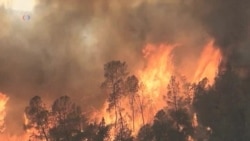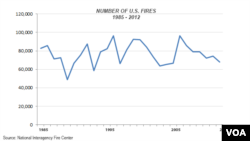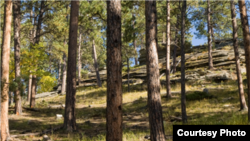WASHINGTON —
In many parts of the world, the prevalence of massive, high-intensity wildfires that were rare only a couple decades ago has been increasing at an alarming rate.
Australia’s 2009 Black Saturday fires, the deadliest civil disaster in that country’s history, killed 173 people, destroyed more than 2,030 houses and incinerated whole towns. In 2010, several hundred fires in Russia burned about 2.3 million hectares and covered Moscow with toxic smoke.
Over the past several years, similar catastrophic wildfires have occurred in numerous countries, including Greece, Israel, Indonesia, Canada, Botswana and Brazil. In the United States, at least nine states have suffered their worst wildfires on record since 1998.
While ignition sources vary (some of the fires were set deliberately for agricultural purposes), fire scientists say most so-called megafires stem from a combination of climate change-induced drought, land use and human mismanagement that has combined to turn landscapes into tinderboxes.
"It’s almost like the return of the ancient plague - we’ve recreated the conditions that make massive fires possible, and they are revisiting us in very harmful ways," said Arizona State University's Stephen Pyne.
The term “megafire” was coined about a dozen years ago in the United States to illustrate the fact that only 1-2 percent of all wildfires had come to account for more than 85 percent of costs and burned area. Similar trends are happening elsewhere.
"In the western United States, we have larger fires occurring over a longer period of time. The fire season - what we have to deal with - is really changing," said Bill Kaage, Wildland Fire Operations Director for the U.S. Park Service at the National Interagency Fire Center (NIFC) in Boise, Idaho.
The numbers are startling. According to the NIFC, 82,591 wildfires in the U.S. burned nearly 1.2 million hectares in 1985. Yet it took only 67,774 fires to consume more than 3.7 million hectares in 2012 - more than a threefold increase.
Drought, Land Use and Fuel
A 2011 United Nations report that examined eight recent megafires cited the "cumulative effects of global warming," particularly the onset of "more pervasive, worldwide drought," as a factor in all but one of the fires. Hot, dry, windy conditions also contributed to their intensity.
Another key element is how land is used, including decades spent protecting sprawling new communities in the developed world's fire-prone areas by aggressively putting out all wildfires.
That policy, called suppression, is politically safe, but has failed in every country naturally prone to fire that has tried it, according to ASU’s Pyne, a fire historian.
"As a temporary fix, when you’re facing a nominal fiscal emergency, or some other issue, when the smoke is on the horizon, and the TV cameras are out, it seems like an easy solution to call in the troops, bring in the airplanes and the helicopters, bomb it away, and then the problem is gone. All we’ve done is put it off," said Pyne.
In other words, suppression creates more dangerous fires later by allowing the build-up of fuel - lower vegetation that can carry fire to the crowns of taller trees.
"Where fires used to burn low-intensity and clean the forest, now they’re burning high-intensity and destroying the forest," said Oregon forester Marc Barnes.
Land use changes in Greece and Portugal, brought on by economic development, have been dramatic. In those nations, fuel build-up has occurred as migrants move into - not out of - cities, leaving large tracts of formerly cared-for land untended.
The Soviet collapse offers yet another scenario, said Pyne, as "Russia and [the successor states of the USSR] have been unable to muster the kind of large-scale fire response they had before."
Rising Costs
In 1985, the U.S. government spent $240 million putting out wildland fires on public and private lands. By 2012, these suppression costs had risen eightfold, to $1.9 billion.
Total federal appropriations for wildland fire management have more than doubled since the late 1990s, averaging $2.9 billion annually in recent years.
A key factor driving up costs is the expansion of residential development - exurban sprawl - in and near wildlands, an area often called the wildland-urban interface.
Since 1970, rural and low-density housing communities in these areas have grown by more than 50 percent, according to fire ecologist and former U.S. Forest Service firefighter Crystal Kolden, writing in The Washington Post.
Numerous studies cite fuel build-up and drought - resulting in less snowpack and drier forests - as other major factors creating more intense fire seasons. Additionally, firefighting resources, such as air support, crews and equipment, are becoming more expensive.
However, costs also are represented in lost lives and property, ecological damage and increased greenhouse gas emissions.
In June 2013, the Black Forest fire in Colorado destroyed 511 houses. Weeks later, Arizona’s Yarnell Hill fire killed 19 highly trained firefighters, members of the elite Granite Mountain Hotshots.
Nearly simultaneously, wildfires in Indonesia - illegally set to convert forest and peat lands into palm oil plantations - sent thick haze billowing across borders, leading to one of Southeast Asia's worst air pollution crises.
The Way Forward
In 2009, the U.S. Congress passed the Flame Act, which mandated a National Cohesive Strategy to fight wildfires, a move Pyne called "bold, but underfunded."
The legislation attempts to coordinate all levels of government, private landowners and NGOs to, as he wrote, "protect against bad fires, promote good ones, and assemble a workforce and the resources to do so."
Barnes cited Oregon's Applegate Partnership as an example of a local non-profit he called "the future for dealing with these issues in the rural West."
Florida, in the southeastern U.S., and Western Australia state offer more examples where - despite severe drought - firefighting costs and damages have been greatly reduced. The U.N. report cited "prescribed burn projects" and "other community-based fire management initiatives" as key factors.
Calls also are increasing for communities in fire-prone areas to retrofit buildings with fire-resistant materials, impose fire taxes and zoning reforms, and for insurance companies to either charge more to protect homes in vulnerable landscapes or abandon them entirely.
U.S. government priorities - and funding - need to shift away from suppression and into such preventive measures, including fuel reduction, Barnes said.
"Otherwise, we’re going to see increasingly bigger fires, spend more money and get a lot less done because so much of [the federal wildland fire] budgets are eclipsed by the money for suppression," he said.
Kaage acknowledged the federal deficit has forced agencies like his to cut their relatively small hazardous fuel reduction budgets - despite recent policy reforms that recognize the essential role fire plays in sustaining natural ecosystems.
"That's a choice we've had to make to ensure we have the engines and the crews available to us for a response. But that doesn't mean we can't be smart about where we treat the fuels and how we treat them to prepare for the arrival of fire," he said.
Australia’s 2009 Black Saturday fires, the deadliest civil disaster in that country’s history, killed 173 people, destroyed more than 2,030 houses and incinerated whole towns. In 2010, several hundred fires in Russia burned about 2.3 million hectares and covered Moscow with toxic smoke.
Over the past several years, similar catastrophic wildfires have occurred in numerous countries, including Greece, Israel, Indonesia, Canada, Botswana and Brazil. In the United States, at least nine states have suffered their worst wildfires on record since 1998.
While ignition sources vary (some of the fires were set deliberately for agricultural purposes), fire scientists say most so-called megafires stem from a combination of climate change-induced drought, land use and human mismanagement that has combined to turn landscapes into tinderboxes.
"It’s almost like the return of the ancient plague - we’ve recreated the conditions that make massive fires possible, and they are revisiting us in very harmful ways," said Arizona State University's Stephen Pyne.
The term “megafire” was coined about a dozen years ago in the United States to illustrate the fact that only 1-2 percent of all wildfires had come to account for more than 85 percent of costs and burned area. Similar trends are happening elsewhere.
"In the western United States, we have larger fires occurring over a longer period of time. The fire season - what we have to deal with - is really changing," said Bill Kaage, Wildland Fire Operations Director for the U.S. Park Service at the National Interagency Fire Center (NIFC) in Boise, Idaho.
The numbers are startling. According to the NIFC, 82,591 wildfires in the U.S. burned nearly 1.2 million hectares in 1985. Yet it took only 67,774 fires to consume more than 3.7 million hectares in 2012 - more than a threefold increase.
Drought, Land Use and Fuel
A 2011 United Nations report that examined eight recent megafires cited the "cumulative effects of global warming," particularly the onset of "more pervasive, worldwide drought," as a factor in all but one of the fires. Hot, dry, windy conditions also contributed to their intensity.
Another key element is how land is used, including decades spent protecting sprawling new communities in the developed world's fire-prone areas by aggressively putting out all wildfires.
That policy, called suppression, is politically safe, but has failed in every country naturally prone to fire that has tried it, according to ASU’s Pyne, a fire historian.
"As a temporary fix, when you’re facing a nominal fiscal emergency, or some other issue, when the smoke is on the horizon, and the TV cameras are out, it seems like an easy solution to call in the troops, bring in the airplanes and the helicopters, bomb it away, and then the problem is gone. All we’ve done is put it off," said Pyne.
In other words, suppression creates more dangerous fires later by allowing the build-up of fuel - lower vegetation that can carry fire to the crowns of taller trees.
"Where fires used to burn low-intensity and clean the forest, now they’re burning high-intensity and destroying the forest," said Oregon forester Marc Barnes.
Land use changes in Greece and Portugal, brought on by economic development, have been dramatic. In those nations, fuel build-up has occurred as migrants move into - not out of - cities, leaving large tracts of formerly cared-for land untended.
The Soviet collapse offers yet another scenario, said Pyne, as "Russia and [the successor states of the USSR] have been unable to muster the kind of large-scale fire response they had before."
Rising Costs
In 1985, the U.S. government spent $240 million putting out wildland fires on public and private lands. By 2012, these suppression costs had risen eightfold, to $1.9 billion.
Total federal appropriations for wildland fire management have more than doubled since the late 1990s, averaging $2.9 billion annually in recent years.
A key factor driving up costs is the expansion of residential development - exurban sprawl - in and near wildlands, an area often called the wildland-urban interface.
Since 1970, rural and low-density housing communities in these areas have grown by more than 50 percent, according to fire ecologist and former U.S. Forest Service firefighter Crystal Kolden, writing in The Washington Post.
Numerous studies cite fuel build-up and drought - resulting in less snowpack and drier forests - as other major factors creating more intense fire seasons. Additionally, firefighting resources, such as air support, crews and equipment, are becoming more expensive.
However, costs also are represented in lost lives and property, ecological damage and increased greenhouse gas emissions.
In June 2013, the Black Forest fire in Colorado destroyed 511 houses. Weeks later, Arizona’s Yarnell Hill fire killed 19 highly trained firefighters, members of the elite Granite Mountain Hotshots.
Nearly simultaneously, wildfires in Indonesia - illegally set to convert forest and peat lands into palm oil plantations - sent thick haze billowing across borders, leading to one of Southeast Asia's worst air pollution crises.
The Way Forward
In 2009, the U.S. Congress passed the Flame Act, which mandated a National Cohesive Strategy to fight wildfires, a move Pyne called "bold, but underfunded."
The legislation attempts to coordinate all levels of government, private landowners and NGOs to, as he wrote, "protect against bad fires, promote good ones, and assemble a workforce and the resources to do so."
Barnes cited Oregon's Applegate Partnership as an example of a local non-profit he called "the future for dealing with these issues in the rural West."
Florida, in the southeastern U.S., and Western Australia state offer more examples where - despite severe drought - firefighting costs and damages have been greatly reduced. The U.N. report cited "prescribed burn projects" and "other community-based fire management initiatives" as key factors.
Calls also are increasing for communities in fire-prone areas to retrofit buildings with fire-resistant materials, impose fire taxes and zoning reforms, and for insurance companies to either charge more to protect homes in vulnerable landscapes or abandon them entirely.
U.S. government priorities - and funding - need to shift away from suppression and into such preventive measures, including fuel reduction, Barnes said.
"Otherwise, we’re going to see increasingly bigger fires, spend more money and get a lot less done because so much of [the federal wildland fire] budgets are eclipsed by the money for suppression," he said.
Kaage acknowledged the federal deficit has forced agencies like his to cut their relatively small hazardous fuel reduction budgets - despite recent policy reforms that recognize the essential role fire plays in sustaining natural ecosystems.
"That's a choice we've had to make to ensure we have the engines and the crews available to us for a response. But that doesn't mean we can't be smart about where we treat the fuels and how we treat them to prepare for the arrival of fire," he said.













